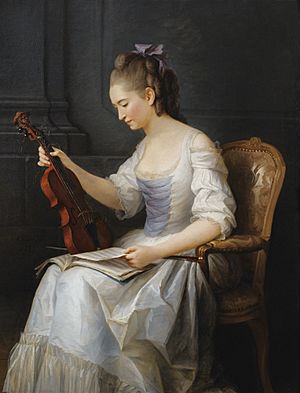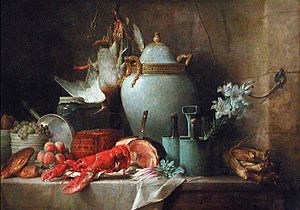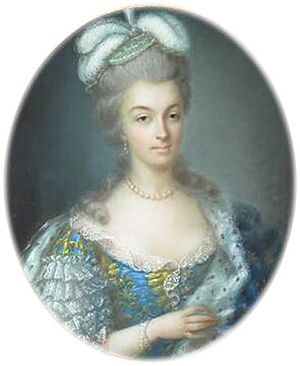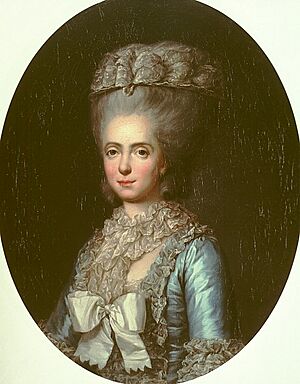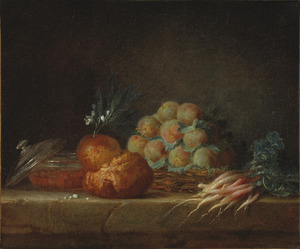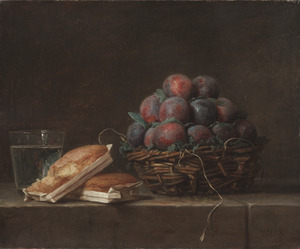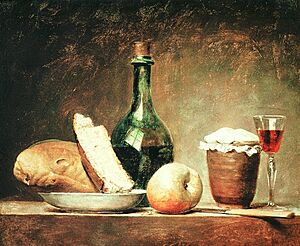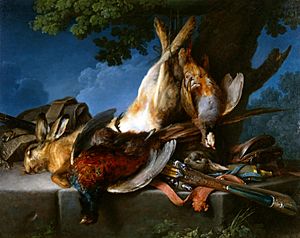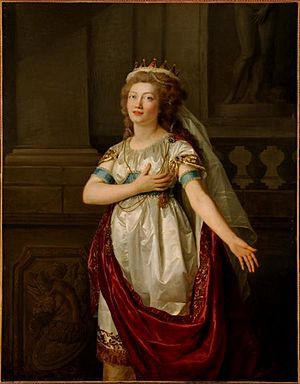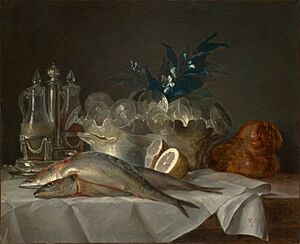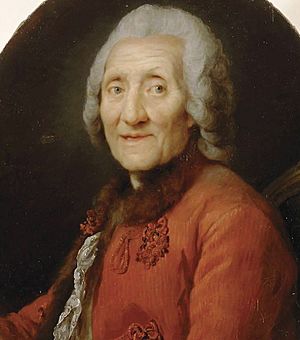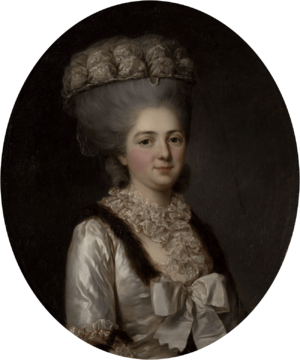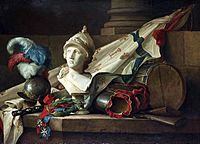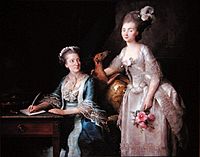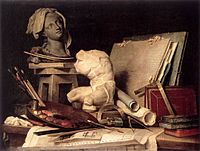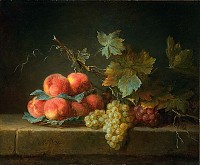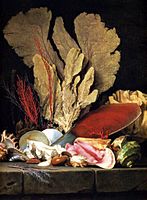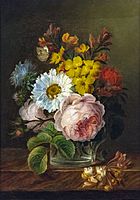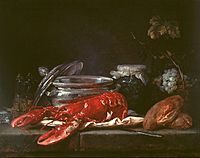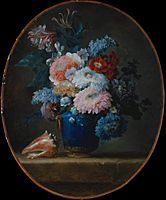Anne Vallayer-Coster facts for kids
Quick facts for kids
Anne Vallayer-Coster
|
|
|---|---|
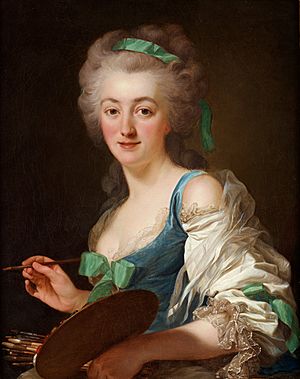
Portrait of Anne Vallayer-Coster by Alexander Roslin (1783), Crocker Art Museum
|
|
| Born | 21 December 1744 |
| Died | 28 February 1818 (aged 73) |
| Nationality | French |
| Known for | Painting |
Anne Vallayer-Coster (born December 21, 1744 – died February 28, 1818) was an important French painter from the 1700s. She is best known for her amazing still life paintings, which show everyday objects like flowers, fruits, and musical instruments.
Anne became famous very early in her career. When she was just 26, she was accepted into the prestigious Académie Royale de Peinture et de Sculpture (Royal Academy of Painting and Sculpture) in 1770. This was a huge achievement, especially for a woman at that time.
Even though still life painting was not considered the most important type of art back then, Anne Vallayer-Coster's incredible skills, especially in painting flowers, quickly got a lot of attention. Important art collectors and other artists admired her work. Her talent even caught the eye of the royal court, and Marie Antoinette, the Queen of France, became very interested in her paintings.
Anne lived a private and dedicated life, focusing on her art. She survived the dangerous period of the French Revolution called the Reign of Terror. However, the fall of the French monarchy, who were her main supporters, caused her fame to fade a bit.
Besides still lifes, she also painted portraits (pictures of people) and genre paintings (scenes from everyday life). But because there were many limits on women artists at the time, she had less success with paintings that featured people.
Contents
Biography
Early Life and Training
Anne Vallayer-Coster was born in 1744 in Paris, France. She was one of four daughters. Her father was a goldsmith for the royal family and worked with the famous Gobelins tapestry factory. It's likely that her family's work with tapestries influenced her interest in art. Many of her paintings were even copied into tapestries by the Gobelins factory.
Her family moved to Paris in 1754. Anne didn't go to a professional painter's studio for training. This was often difficult for respectable women at the time, as they couldn't easily apprentice with unrelated men. Instead, her father taught her. She also learned from other artists, including Madeleine Basseport, who specialized in botanical art, and Joseph Vernet, a famous marine painter.
Starting Her Career
By the time she was 26, Anne Vallayer-Coster was still not widely known. She decided to submit two of her still life paintings, The Attributes of Painting and The Attributes of Music, to the Académie Royale de Peinture et de Sculpture. These paintings were her "reception pieces," meaning they were submitted to show her skill and gain entry into the Academy.
In 1770, the Academicians saw her paintings and unanimously voted her in. This made her one of only 14 women accepted into the Academy before the French Revolution. This success was quickly followed by the sad news of her father's death. Her mother took over the family business, and Anne continued to work hard to support her family.
In 1771, nine more of Vallayer-Coster's paintings were shown at the Salon, a famous art exhibition in Paris. A well-known writer named Denis Diderot praised her work, saying that if all new Academy members were as good as she was, the Salon would be much better! While she was known for still lifes, her portraits also became popular. Her 1773 painting, Portrait of a Violinist, was bought by the Nationalmuseum in 2015.
Anne Vallayer-Coster showed her first floral still life in 1775 and soon became famous for her flower paintings. Four years later, she gained the support of Marie Antoinette, the Queen. With the Queen's help, Anne was given a studio space in the Louvre in 1781, which was very unusual for women artists.
Soon after, in the presence of Marie Antoinette at the Palace of Versailles, Anne married Jean-Pierre Silvestre Coster. He was a wealthy lawyer and an important member of a powerful family. Marie Antoinette even signed their marriage contract as a witness. This marriage gave Anne a very high social standing, almost like old nobility.
Becoming Recognized
Anne received early recognition for her art when she was elected to the Royal Academy in 1770. Her way of starting and keeping her career going was very smart. It was rare for a woman to become a member of the Academy and have such a successful career in the late 1700s. At that time, it was becoming harder for women to be part of public life, and the Academy was not very open to women.
People saw Vallayer-Coster not just as a talented artist but also as a clever diplomat. She understood what her potential supporters wanted and was aware of her unique position as a leading woman artist.
Later Years
In 1793, during the Reign of Terror, the old system that had supported Vallayer-Coster disappeared. Despite her high social status and connection to the Queen, Anne managed to avoid the chaos of the French Revolution in 1789. However, the fall of the French monarchy did affect her career. There is some evidence that she worked for the Gobelins Tapestry factory during this time to continue her art.
Even though her reputation declined, the Empress Josephine, wife of Napoleon, bought two of her paintings in 1804. Vallayer-Coster focused on painting flowers using oil, watercolor, and gouache.
In 1817, she showed her painting Still Life with Lobster at the Paris Salon. This was her last painting shown in public. Experts called it a "summation of her career" because it brought together many of her past subjects. She gave this painting to the restored King Louis XVIII, showing her loyalty to the royal family after the Revolution.
Anne Vallayer-Coster died in 1818 at the age of 73. She had painted more than 120 still lifes, always with bright and beautiful colors.
Artwork
Style and Technique
Vallayer-Coster mainly painted still lifes, a type of art that had been popular for centuries. Still life was often seen as the least important type of painting and was considered suitable for women artists. While she accepted this to join the Academy and get royal support, Vallayer-Coster used her amazing skills to make still lifes serious and interesting.
Anne Vallayer-Coster mostly used oil paints on canvas. She was very good at making materials and textures look real, using precise and smooth brush strokes. Art historian Marianne Roland Michel noted that her "bold, decorative lines," rich colors, and ability to make objects look incredibly real attracted the Royal Academy and many collectors.
Her work shows the clear influence of Jean-Baptiste-Siméon Chardin, another famous still life painter, and Dutch masters from the 1600s. What made Vallayer-Coster's style special was how she combined realistic details with beautiful, organized compositions. She wanted to give a grand feeling to everything she painted, creating a sense of stability and richness.
Exhibitions
In 2002-2003, more than 35 of Vallayer-Coster’s paintings were shown in exhibitions in France and the United States. These shows, titled "Anne Vallayer-Coster: Painter to the Court of Marie Antoinette," were the first to truly represent all her paintings. The exhibitions included works by other artists like Jean-Baptiste-Siméon Chardin and Henri-Horace Roland Delaporte.
In June 2015, the Nationalmuseum in Sweden added Vallayer-Coster’s 1773 Portrait of a Violinist to its collection. The Nationalmuseum also owns her 1775 Still Life with Brioche, Fruit, and Vegetables and a small Floral Still Life. In March 2019, the Kimbell Art Museum bought her 1787 painting called Still Life with Mackerel.
Works by Anne Vallayer-Coster
See also
 In Spanish: Anne Vallayer-Coster para niños
In Spanish: Anne Vallayer-Coster para niños


